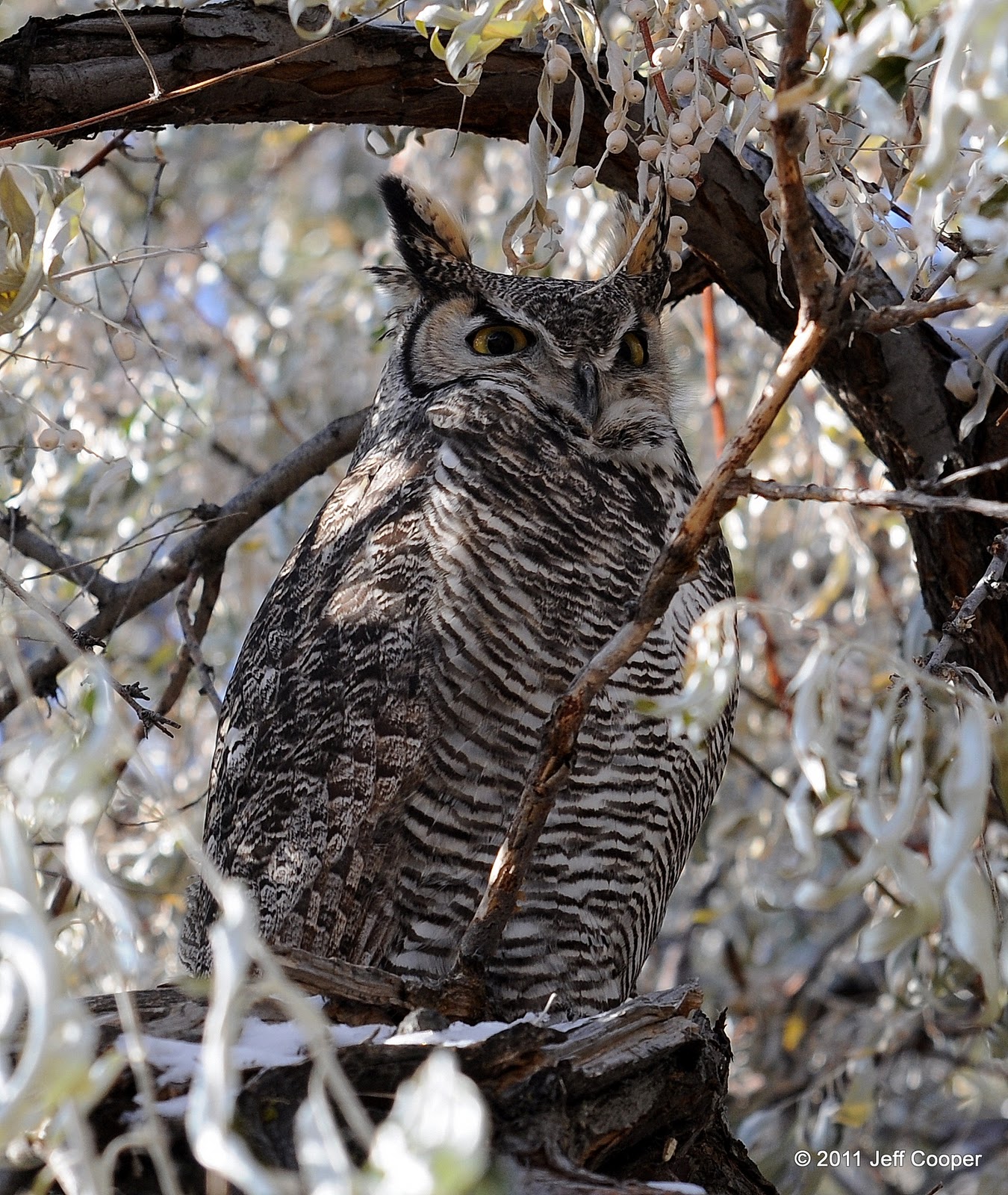 |
Great Horned Owl at Garr Ranch
Antelope Island State Park Davis County, UT
(Photo by Jeff Cooper) |
Owls are mysterious birds because many people know they exist yet few people have seen or understand much about them. Most people I know are familiar with large owls such as Great Horned and Barn Owl, but they have no idea that a number of small owls exist around them.
 |
Barn Owl on Provo Airport Dike Provo, UT
(Photo by Jeff Cooper) |
I will pose some questions as a fun little test of your knowledge of North American Owls in this post, but let me start with a recent experience I had with owls and a non-birder who shares property with a pair of owls. I participated in one of the annual Audubon Christmas Bird Counts last Saturday (12/15/12) by counting bird species in a small area of the Provo Christmas Bird Count. I started before sunrise to include nocturnal birding in my census. I wanted to see if I could locate a Great Horned Owl, Western Screech Owl, and Barn Owl. Despite snowfall, I was able to locate a Great Horned Owl hunting from a tree-top perch within five minutes of starting my census. I saw the silhouette of the tell-tale signs of the Great Horned Owl, two ear tufts and a bulky body. An hour and a half later as the sun began to rise I was still trying to find a Screech Owl and a Barn Owl. Once the sun came up I knew I was not likely to find a Screech Owl because they are strictly nocturnal and very secretive. However, I knew of some abandoned silos and farm buildings in my count area so I knocked on a few doors to obtain permission from property owners to check their buildings. I spoke with one lady and let her know I was doing a bird census for the Audubon Society and that I suspected she may have Barn Owls based on the abandoned buildings and silos near agricultural fields (preferred habitat and hunting areas for Barn Owls). She said, "I don't know if we have Barn Owls, but we have heard some Screech Owls." I suspected that what she was really hearing was the territorial scream (or screech) of Barn Owls. A few minutes into my search of the buildings I found what I was hoping for, an abundance of wash (white excrement) often found beneath an owl roost. I peeked up the shoot of the silo and saw a pair of Barn Owls. Both turned to look down at me and I was able to see the tawny color of the female's face next to her mate's much whiter face. I love following the clues that lead to such discoveries.
Now to the test. Here are a few questions to check your knowledge of North American Owls. I'll present the answers as I have them from one of my favorite books on owls,
Owls of the United States and Canada by Wayne Lynch, at the end of the post (after the images).
1. How many species of owl are recognized in North America?
2. Which four species have dark, rather than yellow, eyes?
3. How many species of Screech Owl can be found in North America?
4. Which is the heaviest owl in North America?
5. Which species has the longest tail relative to its body size and hunts mainly during the day?
6. Which North American species is the smallest owl in the world?
7. Name the species for some of our smaller owls presented below.
This owl was photographed in the mountains of Utah during the summer. It is just under 7 inches tall.
This owl often perches conspicuously and hunts during the day. It was photographed in Provo Canyon in Utah. It is just under 7 inches tall.
This owl was photographed in the mountains of northern Utah in the early summer months. It is about 8 inches tall.
This owl was photographed in the desert just outside of Mesa, AZ at the end of April. It is just under 6 inches tall.
This owl was photographed in Pleasant Grove, UT. It is about 8.5 inches tall.
Answers:
1. 19 Species
2. Barn Owl, Barred Owl, Spotted Owl, Flammulated Owl
3. Western, Eastern, and Whiskered Screech Owls
4. Snowy Owl (the females in particular)
5. Northern Hawk Owl
6. Elf Owl
7. Images from top Flammulated Owl, Northern Pygmy Owl, immature Northern Saw-whet Owl, Elf Owl, Western Screech Owl